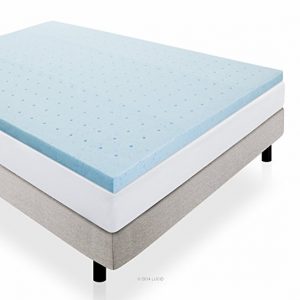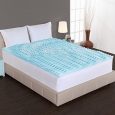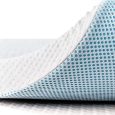
Are you on the quest for the perfect mattress topper but feeling overwhelmed by the seemingly endless options? Look no further, as we’ve got you covered! In this article, we will help you navigate the world of California king mattress toppers and focus specifically on the crucial factor of thickness. Whether you’re looking for added comfort, pressure relief, or simply extending the lifespan of your mattress, finding the ideal thickness for your needs is the key to achieving the ultimate sleep experience. So sit back, relax, and let us guide you towards making the right choice in your quest for the perfect California king mattress topper.
When choosing a mattress topper, there are several factors you should consider to ensure you find the perfect fit for your needs. These factors include your body weight, sleeping position, mattress firmness, and any allergies or sensitivities you may have. By taking these factors into account, you can make a well-informed decision and find a mattress topper that will provide you with the utmost comfort and support.
Body Weight
Your body weight plays a significant role in determining the thickness of the mattress topper you should choose. If you are on the heavier side, a thicker mattress topper may be more suitable as it will provide additional support and prevent excessive sinking into the mattress. Conversely, if you are relatively light, a thinner mattress topper may be sufficient to add a layer of comfort without compromising support.
Sleeping Position
Your sleeping position is another crucial factor to consider when choosing the thickness of a mattress topper. Different sleeping positions require different levels of support and pressure relief. For example, side sleepers may benefit from a thicker mattress topper to cushion their shoulders and hips, while back sleepers may prefer a thinner topper to maintain proper spinal alignment. Stomach sleepers generally require a firmer surface to prevent their hips from sinking too deeply.
Mattress Firmness
The firmness of your mattress is also a factor to consider when selecting the thickness of a mattress topper. If your mattress is already firm and you desire additional cushioning, a thicker topper can provide the plushness you seek. On the other hand, if your mattress is overly soft and lacks support, a thinner topper may be more appropriate to maintain proper spinal alignment.
Allergies and Sensitivities
If you have allergies or sensitivities, it’s essential to consider the materials used in the mattress topper. Some materials may trigger allergies or irritate sensitive skin. In such cases, you may want to opt for hypoallergenic materials or choose a mattress topper that is specifically designed to be resistant to common allergens.
Benefits of a Thick Mattress Topper
A thick mattress topper offers several benefits that can enhance your sleep experience and overall comfort.
Extra Comfort and Cushioning
One of the primary benefits of a thick mattress topper is the extra comfort and cushioning it provides. The additional layer of padding can help alleviate pressure points and create a more plush sleeping surface. Whether you suffer from aching joints or simply enjoy the feeling of sinking into a soft mattress, a thick topper can provide the ultimate comfort you desire.
Pressure Point Relief
Thicker mattress toppers are particularly beneficial for individuals who experience pressure points, especially side sleepers. When you sleep on your side, your shoulders and hips often endure more pressure. A thick mattress topper can help distribute your body weight more evenly and relieve pressure from these areas, promoting better sleep and reducing morning stiffness.
Motion Isolation
If you share your bed with a partner and find yourself frequently disturbed by their movements during the night, a thick mattress topper can help minimize motion transfer. The added cushioning absorbs and isolates movements, preventing them from traveling across the bed. This can allow both you and your partner to enjoy uninterrupted sleep, even if one of you is particularly restless.
Durability
Thicker mattress toppers tend to be more durable compared to their thinner counterparts. The additional padding helps protect the mattress beneath and prevents it from wearing out quickly. This can result in a longer lifespan for both your mattress topper and your mattress, saving you money in the long run.
Benefits of a Thin Mattress Topper
While thick mattress toppers have their advantages, thin mattress toppers also offer a range of benefits that may be more suitable for your needs.
Minimal Alteration to Mattress Feel
If you enjoy the feel of your current mattress but simply want to add a touch of extra comfort, a thin mattress topper may be the perfect choice. Thin toppers provide a subtle layer of cushioning without dramatically altering the overall feel of your mattress. This is especially advantageous if you are happy with the firmness and support of your mattress but desire a bit of extra coziness.
Better Temperature Regulation
Thinner mattress toppers tend to sleep cooler compared to thicker ones. The reduced amount of material and closer proximity to the mattress can help alleviate heat retention, making them ideal for individuals who tend to sleep hot. If you often find yourself waking up in a sweat, a thin mattress topper can help keep you cool and comfortable throughout the night.
Affordability and Ease of Use
Thin mattress toppers generally come at a more affordable price point compared to thicker ones. If you are on a budget but still want to enhance the comfort of your mattress, a thin topper can be a cost-effective solution. Additionally, their lighter weight and thinner profile make them easier to handle and maneuver, simplifying the process of adding or removing the topper as needed.
Ideal for Light Sleepers
If you are a light sleeper who tends to wake up easily, a thin mattress topper can be an optimal choice. The minimal cushioning provided by a thin topper allows for a more direct connection to the mattress, reducing any potential disturbances caused by movement or noise. This can result in a more peaceful and uninterrupted night’s sleep.
Choosing the Right Thickness
When it comes to selecting the thickness of your mattress topper, there are a few key considerations to keep in mind.
Personal Preference
Ultimately, your personal preference should guide your decision-making process. Take the time to think about what you value most in a mattress topper – whether it’s extra cushioning, firm support, or temperature regulation. By aligning your choice with your personal preferences, you can ensure that your mattress topper enhances your sleep experience exactly how you desire.
Support Needs
Consider your support needs when choosing the thickness of your mattress topper. If you require more support due to back pain or joint issues, a thicker topper may be necessary to provide adequate cushioning. Conversely, if you have a relatively firm mattress and simply desire a touch of extra comfort, a thinner topper may suffice.
Current Mattress Condition
Evaluate the condition of your current mattress when determining the thickness of your topper. If your mattress is already sagging or worn out, a thicker topper may be required to compensate for the lack of support. However, if your mattress is in good condition and only needs a slight improvement in comfort, a thinner topper may be sufficient.
Combination Sleepers
If you frequently switch between sleeping positions throughout the night, you’ll want to choose a mattress topper that accommodates your various needs. A medium thickness topper, such as a 2-inch option, can provide a balance of support and cushioning for combination sleepers. This allows for adequate comfort regardless of the position you find yourself in.
Common Thickness Options
Mattress toppers come in various thickness options, ranging from 1 inch to 4 inches. Understanding the differences between these options can help you make an informed decision.
1 inch
A 1-inch mattress topper provides a subtle layer of cushioning, ideal for individuals who desire minimal alteration to the feel of their mattress. This thickness is often chosen by those who have firmer mattresses and only require a slight boost in comfort.
2 inches
A 2-inch mattress topper strikes a balance between cushioning and support. It offers more substantial comfort compared to a 1-inch topper and is suitable for individuals who want a noticeable difference in softness without compromising support.
3 inches
A 3-inch mattress topper provides a more substantial layer of cushioning, making it ideal for side sleepers and individuals who experience pressure points. It offers ample softness and contouring to relieve pressure and promote spinal alignment.
4 inches
A 4-inch mattress topper provides the maximum amount of cushioning and plushness. It’s well-suited for individuals who prefer a truly luxurious and enveloping sleep surface. However, it’s important to consider that a 4-inch topper may significantly alter the overall feel of your mattress.
Matching Thickness to Sleep Position
Different sleep positions require varying levels of support and pressure relief. Here’s a guide to help you choose the appropriate thickness based on your preferred sleep position.
Side Sleepers
Side sleepers often benefit from thicker mattress toppers, such as 3-inch or 4-inch options. These toppers provide ample cushioning to protect their shoulders and hips, which bear more weight in this sleeping position. The extra padding helps relieve pressure points and promotes proper spinal alignment.
Back Sleepers
Back sleepers generally require a more balanced approach when it comes to the thickness of their mattress topper. A 2-inch topper can provide a comfortable amount of cushioning without compromising support. This thickness helps maintain proper alignment of the spine, preventing it from sinking too deeply into the mattress.
Stomach Sleepers
Stomach sleepers often need a firmer sleep surface to prevent their hips from sinking and causing strain on the lower back. A thinner mattress topper, such as a 1-inch option, can provide a bit of extra cushioning while still maintaining the necessary level of support. Thicker toppers may cause the hips to sink too deeply, leading to discomfort and potential alignment issues.
Mattress Topper Materials
Different materials used in mattress toppers offer varying levels of support, comfort, and temperature regulation. Here are some common mattress topper materials to consider:
Memory Foam
Memory foam mattress toppers are renowned for their contouring and pressure-relieving properties. They conform to your body’s curves, providing personalized support and cushioning. Memory foam toppers also absorb motion and reduce disturbances caused by your partner’s movements.
Latex
Latex mattress toppers offer a responsive feel that combines support and comfort. They have a natural bounce and quickly adapt to your body shape while maintaining proper spinal alignment. Latex is also known for its durability and natural hypoallergenic properties.
Fiberfill
Fiberfill mattress toppers are typically made from synthetic or natural fibers such as polyester or cotton. They offer a plush, cushioned feel and are often more affordable compared to other materials. Fiberfill toppers are a good choice for individuals who desire a soft sleeping surface without excessive sinkage.
Gel-infused Foam
Gel-infused foam mattress toppers combine the contouring effects of memory foam with enhanced temperature regulation. The gel infusion helps dissipate heat, preventing the topper from sleeping hot. This makes gel-infused foam toppers ideal for individuals who tend to sleep warm but still want the benefits of memory foam.
Cost Considerations
When choosing a mattress topper, it’s important to consider both the initial investment and the long-term value you will receive.
Initial Investment
The cost of a mattress topper can vary depending on the material, thickness, and brand. Thicker toppers and those made from premium materials often come with a higher price tag. However, keep in mind that a higher initial cost may be worth it if you value the added comfort and durability these toppers offer.
Long-Term Value
While thicker or higher-quality mattress toppers may have a higher upfront cost, they often provide better long-term value. Toppers that are more durable and resistant to wear and tear can last longer, meaning you won’t need to replace them as frequently. Additionally, investing in a mattress topper that meets your specific needs can lead to improved sleep quality and overall well-being, making it a worthy long-term investment.
Maintenance and Cleaning
To ensure your mattress topper remains in optimal condition, it’s important to follow proper maintenance and cleaning practices.
Machine Washable
Some mattress toppers are machine washable, making the cleaning process more convenient. Before throwing your topper in the washing machine, make sure to check the manufacturer’s instructions for any specific guidelines. Using a mild detergent and a gentle cycle can help maintain the integrity of the topper while removing any dirt or stains.
Spot Cleaning
If your mattress topper is not machine washable or if you only need to address a specific stain or spill, spot cleaning is the way to go. Start by gently blotting the affected area with a clean cloth or sponge, taking care not to rub or scrub vigorously. Use a mild detergent mixed with water to clean the spot, and then blot with a clean, damp cloth to remove any soapy residue. Allow the topper to air dry completely before placing it back on your bed.
Air Drying
Most mattress toppers should be air dried to maintain their shape and integrity. Lay the topper flat on a clean surface in a well-ventilated area, preferably outdoors or in a room with good air circulation. Avoid direct sunlight, as prolonged exposure to sunlight can cause the materials to deteriorate. It’s important to allow the topper to dry thoroughly before using it again to prevent any potential mold or mildew growth.
Protective Covers
Using a protective cover for your mattress topper can help prolong its lifespan and keep it clean. These covers act as a barrier, preventing stains, dirt, and allergens from penetrating the topper. Some protective covers also provide additional waterproofing, safeguarding your topper against spills and accidents. Make sure to choose a cover that is the appropriate size for your mattress topper and follow the manufacturer’s instructions for proper care and maintenance.
Conclusion
Choosing the right thickness in a California king mattress topper is crucial for achieving optimal comfort and support while you sleep. By considering factors such as body weight, sleeping position, mattress firmness, and allergies or sensitivities, you can make an informed decision. Whether you opt for a thick topper for extra comfort and pressure point relief or a thin topper for minimal alteration to the mattress feel, there are benefits to be gained from both options. Remember to align your choice with your personal preferences, support needs, and the condition of your current mattress. Additionally, consider the different materials available for mattress toppers and their respective benefits. Lastly, maintain and clean your mattress topper regularly to ensure its longevity and keep it in pristine condition. With the right thickness, material, and care, your California king mattress topper can provide you with the ultimate sleeping experience you deserve.



